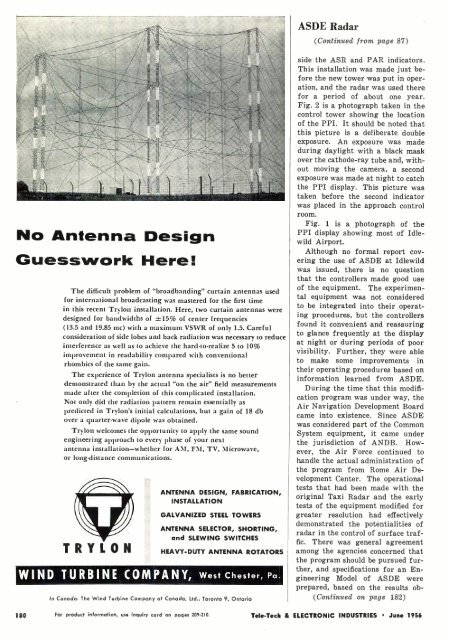TELE-TECH & - AmericanRadioHistory.Com
TELE-TECH & - AmericanRadioHistory.Com
TELE-TECH & - AmericanRadioHistory.Com
Create successful ePaper yourself
Turn your PDF publications into a flip-book with our unique Google optimized e-Paper software.
ASDE Radar<br />
(Continued from page 87)<br />
No Antenna Design<br />
Guesswork Here!<br />
The difficult problem of "broadbanding" curtain antennas used<br />
for international broadcasting was mastered for the first time<br />
in this recent Trylon installation. Here, two curtain antennas were<br />
designed for bandwidths of ±15% of center frequencies<br />
(13.5 and 19.85 mc) with a maximum VSWR of only 1.5. Careful<br />
consideration of side lobes and back radiation was necessary to reduce<br />
interference as well as to achieve the hard -to- realize 5 to 10%<br />
improvement in readability compared with conventional<br />
rhombics of the same gain.<br />
The experience of Try lon antenna specialists is no better<br />
demonstrated than by the actual "on the air" field measurements<br />
made after the completion of this complicated installation.<br />
Not only did the radiation pattern remain essentially as<br />
predicted in Trylon's initial calculations, but a gain of 18 db<br />
over a quarter -wave dipole was obtained.<br />
Trylon welcomes the opportunity to apply the same sound<br />
engineering approach to every phase of your next<br />
antenna installation -whether for AM, FM, TV, Microwave,<br />
or long -distance communications.<br />
TRYLON<br />
ANTENNA DESIGN, FABRICATION,<br />
INSTALLATION<br />
GALVANIZED STEEL TOWERS<br />
ANTENNA SELECTOR, SHORTING,<br />
and SLEWING SWITCHES<br />
HEAVY -DUTY ANTENNA ROTATORS<br />
WIND TURBINE COMPANY, West Chester, Pa.<br />
In Canada: The Wind Turbine <strong>Com</strong>pany of Canada, Ltd., Toronto 9, Ontario<br />
side the ASR and PAR indicators.<br />
This installation was made just before<br />
the new tower was put in operation,<br />
and the radar was used there<br />
for a period of about one year.<br />
Fig. 2 is a photograph taken in the<br />
control tower showing the location<br />
of the PPI. It should be noted that<br />
this picture is a deliberate double<br />
exposure. An exposure was made<br />
during daylight with a black mask<br />
over the cathode -ray tube and, without<br />
moving the camera, a second<br />
exposure was made at night to catch<br />
the PPI display. This picture was<br />
taken before the second indicator<br />
was placed in the approach control<br />
room.<br />
Fig. 1 is a photograph of the<br />
PPI display showing most of Idle -<br />
wild Airport.<br />
Although no formal report covering<br />
the use of ASDE at Idlewild<br />
was issued, there is no question<br />
that the controllers made good use<br />
of the equipment. The experimental<br />
equipment was not considered<br />
to be integrated into their operating<br />
procedures, but the controllers<br />
found it convenient and reassuring<br />
to glance frequently at the display<br />
at night or during periods of poor<br />
visibility. Further, they were able<br />
to make some improvements in<br />
their operating procedures based on<br />
information learned from ASDE.<br />
During the time that this modification<br />
program was under way, the<br />
Air Navigation Development Board<br />
came into existence. Since ASDE<br />
was considered part of the <strong>Com</strong>mon<br />
System equipment, it came under<br />
the jurisdiction of ANDB. However,<br />
the Air Force continued to<br />
handle the actual administration of<br />
the program from Rome Air Development<br />
Center. The operational<br />
tests that had been made with the<br />
original Taxi Radar and the early<br />
tests of the equipment modified for<br />
greater resolution had effectively<br />
demonstrated the potentialities of<br />
radar in the control of surface traffic.<br />
There was general agreement<br />
among the agencies concerned that<br />
the program should be pursued further,<br />
and specifications for an Engineering<br />
Model of ASDE were<br />
prepared, based on the results ob-<br />
(Continued on page 182)<br />
180 For product information, use inquiry cord on pages 209 -210.<br />
Tele -Tech & ELECTRONIC INDUSTRIES June 1956
















